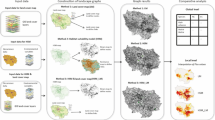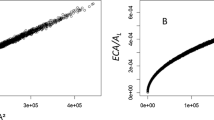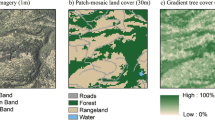Abstract
Context
Landscape graphs are widely used to model networks of habitat patches. As they require little input data, they are particularly suitable for supporting conservation decisions (and decisions about other issues as e.g. disease spread) taken by land planners. However, it may be problematic to use these methods in operational contexts without validating them with empirical data on species or communities.
Objectives
Since little is known about methodological alternatives for coupling landscape graphs with biological data, we have made an exhaustive review of these methods to analyze links between the main purposes of the studies, the way landscape graphs are constructed and used, the type of field data, and the way these data are integrated into the analysis.
Methods
We systematically describe a corpus of 71 scientific papers dealing with terrestrial species, with particular emphasis on methodological choices and contexts of the studies.
Results
Despite a great variability of types of biological data and coupling strategies, our analyses reveal a dichotomy according to the objective of the studies, between (i) approaches aimed at improving ecological knowledge, mainly based on land-cover maps and using biological data to test the influence of landscape connectivity on biological responses, and (ii) approaches with an operational aim, in which biological data are directly integrated into the graph construction and assuming a positive effect of connectivity.
Conclusions
Beyond these main contrasts, the review shows that landscape graphs can benefit from field data of different types at varying scales. The great variability of approaches adopted reveals the flexible nature of these tools.






Similar content being viewed by others
Change history
15 May 2020
In the original publication of the article, the sixth author name has been misspelt. The correct name is given in this Correction. The original article has been corrected.
References
Allendorf FW, Luikart GH, Aitken SN (2012) Conservation and the genetics of populations, 2nd edn. Wiley Blackwell, New York
Andersson E, Bodin O (2009) Practical tool for landscape planning? An empirical investigation of network based models of habitat fragmentation. Ecography 32:123–132
Avon C, Bergès L (2016) Prioritization of habitat patches for landscape connectivity conservation differs between least-cost and resistance distances. Landsc Ecol 31:1551–1565
Awade M, Boscolo D, Metzger JP (2012) Using binary and probabilistic habitat availability indices derived from graph theory to model bird occurrence in fragmented forests. Landsc Ecol 27:185–198
Beier P, Majka DR, Spencer WD (2008) Forks in the road: choices in procedures for designing wildland linkages. Conserv Biol 22:836–851
Bergerot B, Tournant P, Moussus JP, Stevens V, Julliard R, Baguette M, Foltête JC (2013) Coupling inter-patch movement models and landscape graph to assess functional connectivity. Popul Ecol 55:193–203
Bergsten A, Zetterberg A (2013) To model the landscape as a network: a practitioner’s perspective. Landsc Urban Plan 119:35–43
Betbeder J, Laslier M, Hubert-Moy L, Burel F, Baudry J (2017) Synthetic Aperture Radar (SAR) images improve habitat suitability models. Landsc Ecol 32:1867–1879
Bunn AG, Urban DL, Keitt TH (2000) Landscape connectivity: a conservation application of graph theory. J Environ Manag 59:265–278
Calabrese JM, Fagan WF (2004) A comparison-shopper’s guide to connectivity metrics. Front Ecol Environ 2:529–536
Clauzel C, Girardet X, Foltête JC (2013) Impact assessment of a high-speed railway line on species distribution: application to the European tree frog (Hyla arborea) in Franche-Comté. J Environ Manag 127:125–134
Clevenger AP, Wierzchowski J, Chruszcz B, Gunson K (2002) GIS-generated, expert-based models for identifying wildlife habitat linkages and planning mitigation passages. Conserv Biol 16:503–514
Correa Ayram CA, Mendoza ME, Etter A, Pérez Salicrup DR (2016) Habitat connectivity in biodiversity conservation: a review of recent studies and applications. Prog Phys Geogr 40:7–37
Crooks KR, Sanjayan M (eds) (2006) Connectivity conservation. Cambridge University Press, Cambridge
Csardi G, Nepusz T (2006) The igraph software package for complex network research. InterJ Complex Syst 1695:1–9
Cushman SA, McRae B, Adriaensen F, Beier P, Shirley M, Zeller K (2013) Biological corridors and connectivity. In: Macdonald DW, Willis KJ (eds) Key topics in conservation biology 2. Wiley-Blackwell, Malden, pp 384–404
Dale MRT, Fortin MJ (2010) From graphs to spatial graphs. Annu Rev Ecol Evol Syst 41:21–38
Dondina O, Saura S, Bani L, Mateo-Sánchez MC (2018) Enhancing connectivity in agroecosystems: focus on the best existing corridors or on new pathways? Landsc Ecol 33:1741–1756
Duflot R, Avon C, Roche P, Bergès L (2018) Combining habitat suitability models and spatial graphs for more effective landscape conservation planning: an applied methodological framework and a species case study. J Nat Conserv 46:38–47
Estrada-Peña A (2005) Effects of habitat suitability and landscape patterns on tick (Acarina) metapopulation processes. Landsc Ecol 20:529–541
Fall A, Fortin MJ, Manseau M, O’Brien D (2007) Spatial graphs: principles and applications for habitat connectivity. Ecosystems 10:448–461
Fletcher RJ, Burrel NS, Reichert BE, Vasudev D, Austin JD (2016) Divergent perspectives on landscape connectivity reveal consistent effects from genes to communities. Curr Landsc Ecol Rep 1:67–79
Foltête JC, Clauzel C, Vuidel G (2012a) A software tool dedicated to the modelling of landscape networks. Environ Model Softw 38:316–327
Foltête JC, Clauzel C, Vuidel G, Tournant P (2012b) Integrating graph-based connectivity metrics into species distribution models. Landsc Ecol 27:557–569
Foltête JC, Girardet X, Clauzel C (2014) A methodological framework for the use of landscape graphs in land-use planning. Landsc Urban Plan 124:140–150
Foltête JC, Giraudoux P (2012) A graph-based approach to investigating the influence of the landscape on population spread processes. Ecol Indic 18:684–692
Galpern P, Manseau M, Fall A (2011) Patch-based graphs of landscape connectivity: a guide to construction, analysis and application for conservation. Biol Conserv 144:44–55
Galpern P, Manseau M, Wilson P (2012) Grains of connectivity: analysis at multiple spatial scales in landscape genetics. Mol Ecol 21:3996–4009
Gil-Tena A, Nabucet J, Mony C, Abadie J, Saura S, Butet A, Burel F, Ernoult A (2014) Woodland bird response to landscape connectivity in an agriculture-dominated landscape: a functional community approach. Community Ecol 15:256–268
Gippoliti S, Battisti C (2017) More cool than tool: equivoques, conceptual traps and weaknesses of ecological networks in environmental planning and conservation. Land Use Policy 68:686–691
Kadoya T (2008) Assessing functional connectivity using empirical data. Popul Ecol 51:5–15
Keller D, Holderegger R, Van Strien MJ (2013) Spatial scale affects landscape genetic analysis of a wetland grasshopper. Mol Ecol 22:2467–2482
Keyghobadi N (2007) The genetic implications of habitat fragmentation for animals. Can J Zool 85:1049–1064
Khimoun A, Peterman W, Eraud C, Faivre B, Navarro N, Garnier S (2017) Landscape genetic analyses reveal fine-scale effects of forest fragmentation in an insular tropical bird. Mol Ecol 26:4906–4919
Koh I, Rowe HI, Holland JD (2013) Graph and circuit theory connectivity models of conservation biological control agents. Ecol Appl 23:1554–1573
Landguth EL, Cushman SA, Schwartz MK, McKelvey KS, Murphy M, Luikart G (2010) Quantifying the lag time to detect barriers in landscape genetics. Mol Ecol 19:4179–4191
Lindenmayer DB, Fischer J (2006) Habitat fragmentation and landscape change; an ecological and conservation synthesis. Island Press, Washington
MacArthur RH, Wilson EO (1967) The theory of island biogeography. Princeton University Press, Princeton
Martensen AG, Saura S, Fortin MJ (2017) Spatio-temporal connectivity: assessing the amount of reachable habitat in dynamic landscapes. Methods Ecol Evol 8:1253–1264
Martín-Queller E, Albert CH, Dumas PJ, Saatkamp A (2017) Islands, mainland, and terrestrial fragments: how isolation shapes plant diversity. Ecol Evol 7:6904–6917
Martín-Queller E, Saura S (2013) Landscape species pools and connectivity patterns influence tree species richness in both managed and unmanaged stands. For Ecol Manag 289:123–132
Melles S, Fortin MJ, Badzinski D, Lindsay K (2012) Relative importance of nesting habitat and measures of connectivity in predicting the occurrence of a forest songbird in fragmented landscapes. Avian Conserv Ecol 7(2):3
Minor ES, Urban DL (2008) A graph-theory framework for evaluating landscape connectivity and conservation planning. Conserv Biol 22:297–307
Moilanen A (2011) On the limitations of graph-theoretic connectivity in spatial ecology and conservation. J Appl Ecol 48:1543–1547
Mony C, Abadie J, Gil-Tena A, Burel F, Ernoult A (2018) Effects of connectivity on animal-dispersed forest plant communities in agriculture-dominated landscapes. J Veg Sci 29:167–178
Morán-López T, Robledo-Arnuncio JJ, Díaz M, Morales JM, Lázaro-Nogal A, Lorenzo Z, Valladares F (2016) Determinants of functional connectivity of holm oak woodlands: fragment size and mouse foraging behavior. For Ecol Manag 368:111–122
Muratet A, Lorrillière R, Clergeau P, Fontaine C (2013) Evaluation of landscape connectivity at community level using satellite-derived NDVI. Landsc Ecol 28:95–105
Neel MC (2008) Patch connectivity and genetic diversity conservation in the federally endangered and narrowly endemic plant species Astragalus albens (Fabaceae). Biol Conserv 141:938–955
O’Brien D, Manseau M, Fall A, Forti MJ (2006) Testing the importance of spatial configuration of winter habitat for woodland caribou: an application of graph theory. Biol Conserv 130:70–83
Pascual-Hortal L, Saura S (2006) Comparison and development of new graph-based landscape connectivity indices: towards the priorization of habitat patches and corridors for conservation. Landsc Ecol 21:959–967
Pe’er G, Salz D, Frank K (2005) Virtual corridors for conservation management. Conserv Biol 16:1997–2003
Peterman WE, Connette GM, Semlitsch RD, Eggert LS (2014) Ecological resistance surfaces predict fine-scale genetic differentiation in a terrestrial woodland salamander. Mol Ecol 23:2402–2413
Pianosi F, Beven K, Freer J, Hall JW, Rougier J, Stephenson DB, Wagener T (2016) Sensitivity analysis of environmental models: a systematic review with practical workflow. Environ Model Softw 79:214–232
Poor EE, Shao Y, Kelly MJ (2019) Mapping and predicting forest loss in a Sumatran tiger landscape from 2002 to 2050. J Environ Manag 231:397–404
Pressey RL (2004) Conservation planning and biodiversity: assembling the best data for the job. Conserv Biol 18:1677–1681
Rayfield B, Fortin MJ, Fall A (2011) Connectivity for conservation: a framework to classify network measures. Ecology 92:847–858
Ribeiro R, Carretero MA, Sillero N, Alarcos G, Ortiz-Santaliestra M, Lizana M, Llorente GA (2011) The pond network: can structural connectivity reflect on (amphibian) biodiversity patterns? Landsc Ecol 26:673–682
Saura S, Pascual-Hortal L (2007) A new habitat availability index to integrate connectivity in landscape conservation planning: comparison with existing indices and application to a case study. Landsc Urban Plan 83:91–103
Saura S, Rubio L (2010) A common currency for the different ways in which patches and links can contribute to habitat availability and connectivity in the landscape. Ecography 33:523–537
Saura S, Torné J (2009) ConeforSensinode 2.2: a software package for quantifying the importance of habitat patches for landscape connectivity. Environ Model Softw 24:135–139
Schoville SD, Dalongeville A, Viennois G, Gugerli F, Taberlet P, Lequette B, Alvarez N, Manel S (2018) Preserving genetic connectivity in the European Alps protected area network. Biol Conserv 218:99–109
Shirk AJ, Wallin DO, Cushman SA, Rice CG, Warheit KI (2010) Inferring landscape effects on gene flow: a new model selection framework. Mol Ecol 19:3603–3619
Song W, Kim E (2016) Landscape factors affecting the distribution of the great tit in fragmented urban forests of Seoul, South Korea. Landsc Ecol Engine 12:73–83
Spear SF, Balkenhol N, Fortin MJ, McRae BH, Scribner KIM (2010) Use of resistance surfaces for landscape genetic studies: considerations for parameterization and analysis. Mol Ecol 19:3576–3591
Taberlet P, Zimmermann NE, Englisch T, Tribsch A, Holderegger R, Nadir Alvarez N, Niklfeld H, Coldea G, Mirek Z, Moilanen A, Ahlmer W, Ajmone-Marsan P, Bona E, Bovio M, Choler P, Cieślak E, Colli L, Cristea V, Dalmas JP, Frajman B, Garraud G, Gaudeul M, Gielly L, Gutermann W, Jogan N, Kagalo AA, Korbecka G, Küpfer P, Lequette B, Roman Letz D, Manel S, Mansion G, Marhold K, Martini F, Negrini R, Niño F, Paun O, Pellecchia M, Perico G, Piękoś-Mirkowa H, Prosser F, Puşcaş M, Ronikier M, Scheuerer M, Schneeweiss GM, Schönswetter P, Schratt-Ehrendorfer L, Schüpfer F, Selvaggi A, Steinmann K, Thiel-Egenter C, van Loo M, Winkler M, Wohlgemuth T, Wraber T, Gugerli F, IntraBioDiv Consortium (2012) Genetic diversity in widespread species is not congruent with species richness in alpine plant communities. Ecol Lett 15:1439–1448
Tannier C, Bourgeois M, Houot H, Foltête JC (2016) Impact of urban developments on the functional connectivity of forested habitats: a joint contribution of advanced urban models and landscape graphs. Land Use Policy 52:76–91
Tenenhaus M, Young FW (1985) An analysis and synthesis of multiple correspondence analysis, optimal scaling, homogeneity analysis and other methods for quantifying categorical multivariate data. Psychometrika 50:91–119
Tournant P, Afonso E, Giraudoux P, Roué S, Foltête JC (2013) Evaluating the effect of habitat connectivity on the distribution of lesser horseshoe bat maternity roosts using landscape graphs. Biol Conserv 164:39–49
Urban DL, Keitt TH (2001) Landscape connectivity: a graph theoretic approach. Ecology 82:1205–1218
Urban DL, Minor ES, Treml EA, Schick RS (2009) Graph models of land mosaics. Ecol Lett 12:260–273
Vellend M, Geber MA (2005) Connections between species and genetic diversity. Ecol Lett 8:767–781
Wasserman TN, Cushman SA, Schwartz MK, Wallin DO (2010) Spatial scaling and multi-model inference in landscape genetics: Martes americana in northern Idaho. Landsc Ecol 25:1601–1612
Zeller KA, Jennings MK, Vickers TW, Ernest HB, Cushman SA, Boyce WM (2018) Are all data types and connectivity models created equal? Validating common connectivity approaches with dispersal data. Divers Distrib 24:868–879
Zeller KA, McGarigal K, Whiteley AR (2012) Estimating landscape resistance to movement: a review. Lands Ecol 27:777–797
Zetterberg A, Mörtberg UM, Balfors B (2010) Making graph theory operational for landscape ecological assessments, planning, and design. Landsc Urban Plan 95:191–191
Author information
Authors and Affiliations
Corresponding author
Additional information
Publisher's Note
Springer Nature remains neutral with regard to jurisdictional claims in published maps and institutional affiliations.
The original version of this article was revised: the sixth author name was updated.
Electronic supplementary material
Below is the link to the electronic supplementary material.
Rights and permissions
About this article
Cite this article
Foltête, JC., Savary, P., Clauzel, C. et al. Coupling landscape graph modeling and biological data: a review. Landscape Ecol 35, 1035–1052 (2020). https://doi.org/10.1007/s10980-020-00998-7
Received:
Accepted:
Published:
Issue Date:
DOI: https://doi.org/10.1007/s10980-020-00998-7




